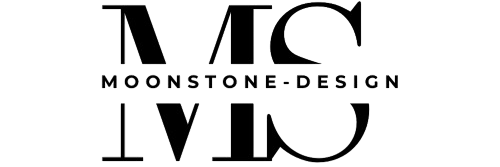Picture this: You step into your workshop, and everything just clicks. Tools are exactly where you need them, lighting illuminates every corner perfectly, and the space itself seems to fuel your creative fire. This isn’t just a dream—it’s what happens when thoughtful design meets practical functionality.
Whether you’re a weekend warrior tackling DIY projects, a seasoned craftsperson perfecting your trade, or someone just starting their maker journey, your workshop should be more than just a place to store tools. It should be your creative sanctuary, productivity powerhouse, and the launching pad for every brilliant idea that crosses your mind.
In this comprehensive guide, we’ll explore 15 game-changing workshop design concepts that will revolutionize how you think about your workspace. From maximizing every square inch of a tiny garage corner to incorporating cutting-edge smart technology, these ideas will help you craft a workshop that’s uniquely yours.
Ready to transform your space into the workshop of your dreams? Let’s dive in.
1. Budget-Friendly Workshop Design Ideas for Beginners

Starting your workshop journey doesn’t require breaking the bank. The secret lies in creative resourcefulness and smart shopping strategies.
Transform old furniture into functional workspace elements—that forgotten dining table can become your primary workbench with a few modifications. Embrace DIY storage solutions using repurposed materials like wooden crates for shelving or mason jars for small hardware organization.
Hunt for second-hand tools at estate sales, flea markets, and online marketplaces. Many quality tools just need a little cleaning and maintenance to serve you for years. Consider pegboards as your organizational backbone—they’re affordable, versatile, and can grow with your tool collection.
Stackable crates and foldable workbenches offer maximum functionality while keeping costs minimal. Remember, a well-organized basic workshop often outperforms a cluttered expensive one.
2. Advanced Workshop Design for Professionals
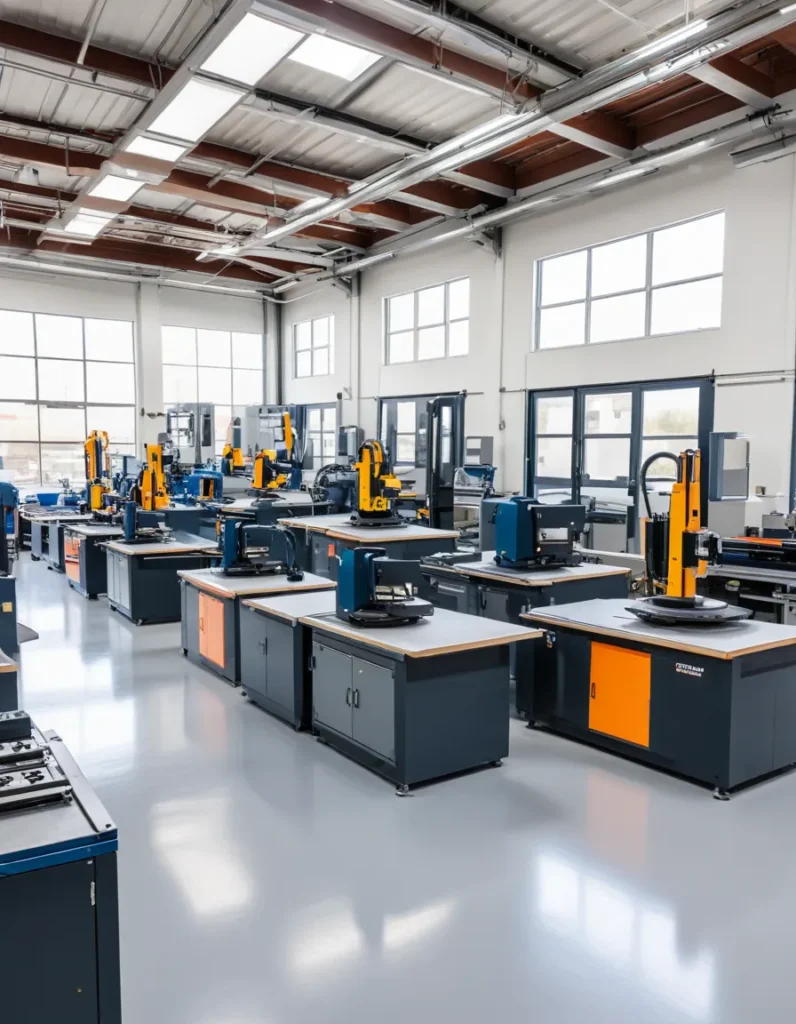
Professional-grade workshops demand precision, efficiency, and durability in every element. Your workspace should reflect the quality of work you produce.
Invest in industrial-strength workbenches that can withstand heavy use and maintain accuracy over time. Heavy-duty storage systems with labeled compartments ensure every tool has its designated place, reducing project time and increasing productivity.
Specialized work zones become crucial—designate specific areas for precision work, assembly, finishing, and quality control. Each zone should have dedicated lighting, ventilation, and tool storage tailored to its specific requirements.
Consider integrating advanced technology like laser cutters, CNC machines, and 3D printers for expanded capabilities. Professional-grade dust collection systems and soundproofing create a healthier, more pleasant working environment that allows for longer, more focused work sessions.
3. Portable Workshop Setups for Small Spaces
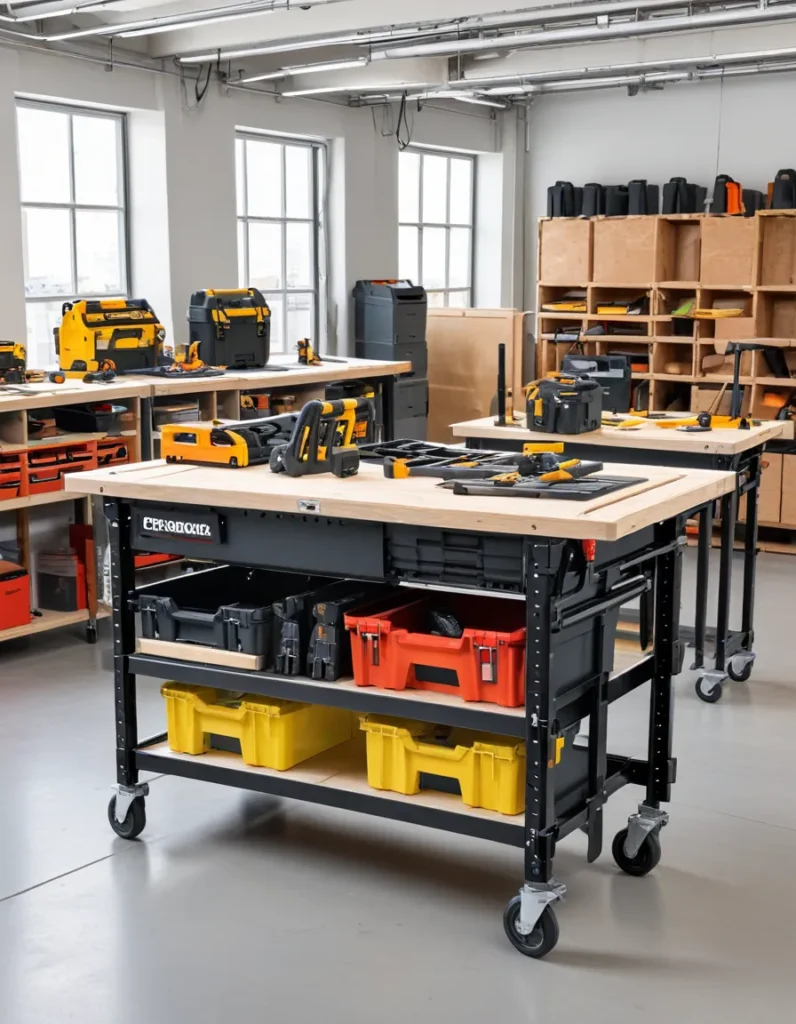
Limited space doesn’t mean limited potential. Portable workshop setups maximize functionality while maintaining flexibility for various living situations.
Collapsible tables serve as your foundation—look for models with adjustable heights and built-in storage. Stackable storage bins create vertical organization that can be easily reconfigured as your needs change.
Mobile toolboxes become your command centers, keeping essential tools within arm’s reach regardless of your current project location. Choose compact, portable power tools that deliver professional results without requiring permanent installation.
Consider wheeled carts that can transform any flat surface into a temporary workshop. This approach works perfectly for apartment dwellers, renters, or anyone who needs to share their space with other activities.
4. Designing a Workshop with Safety Features in Mind
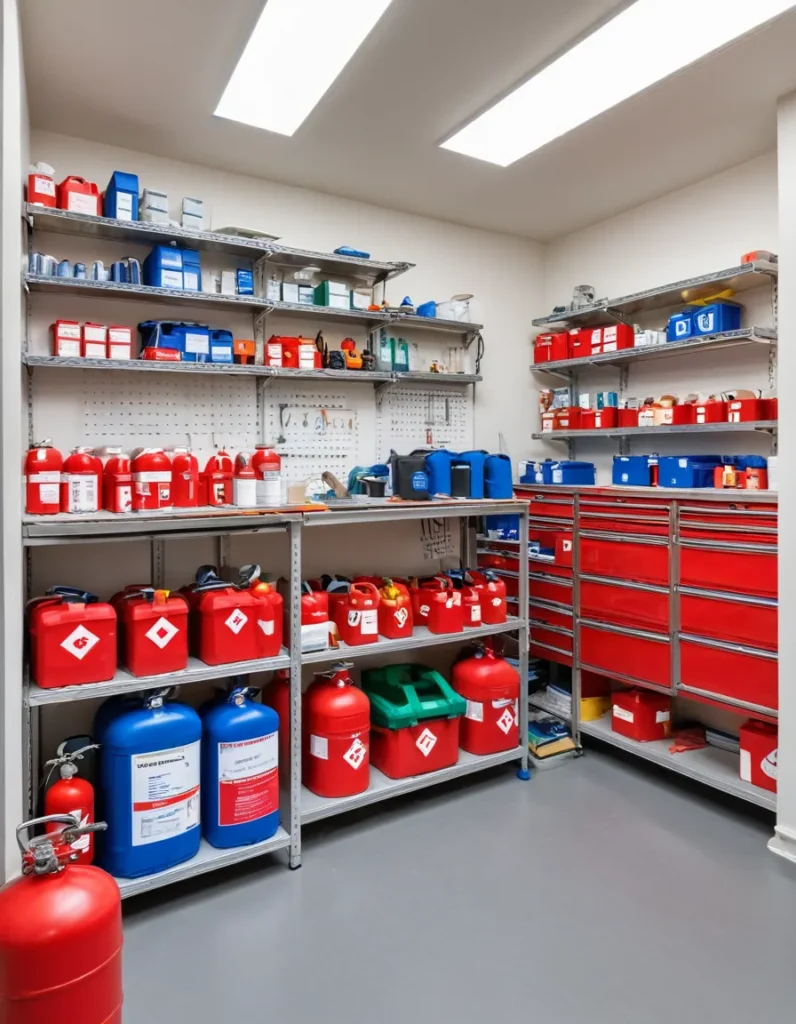
Safety isn’t just a priority—it’s the foundation that makes everything else possible. A well-designed safety system protects both you and your investment in tools and projects.
Strategic placement of fire extinguishers, first aid kits, and emergency shutoffs should be your starting point. Every workshop needs multiple escape routes and clear sight lines to all exits.
Implement comprehensive ventilation systems that handle both dust and chemical fumes. This includes both general air circulation and targeted extraction at point sources like sanders and spray booths.
Non-slip flooring materials prevent accidents, while proper machine anchoring eliminates dangerous vibrations. Clear safety signage and emergency contact information should be visible from any point in the workshop.
Regular safety audits help identify potential hazards before they become problems. Make safety equipment maintenance part of your routine workshop upkeep.
5. Using Color Schemes to Enhance Workshop Productivity
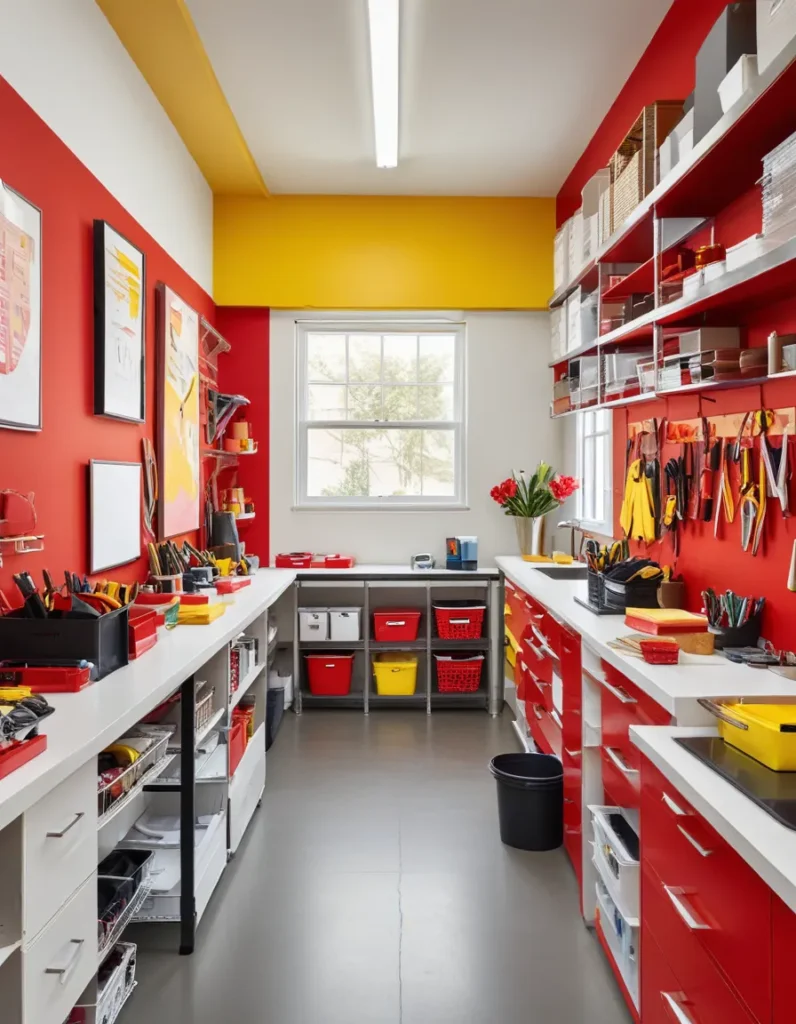
Color psychology plays a significant role in workspace productivity and mood. The right color scheme can energize, focus, and inspire your best work.
Light bases like white or pale gray create an illusion of spaciousness while providing excellent contrast for tool identification. These neutral foundations also maximize the effectiveness of your lighting system.
Strategic accent colors can boost energy and creativity—consider warm yellows for inspiration zones or calming blues for precision work areas. Red accents can increase urgency and focus but should be used sparingly to avoid overwhelming the space.
Consistency in storage area colors creates visual harmony and makes organization more intuitive. Color-coding different tool types or project categories can speed up both setup and cleanup processes.
6. Creating a Comfortable Workshop Seating Area
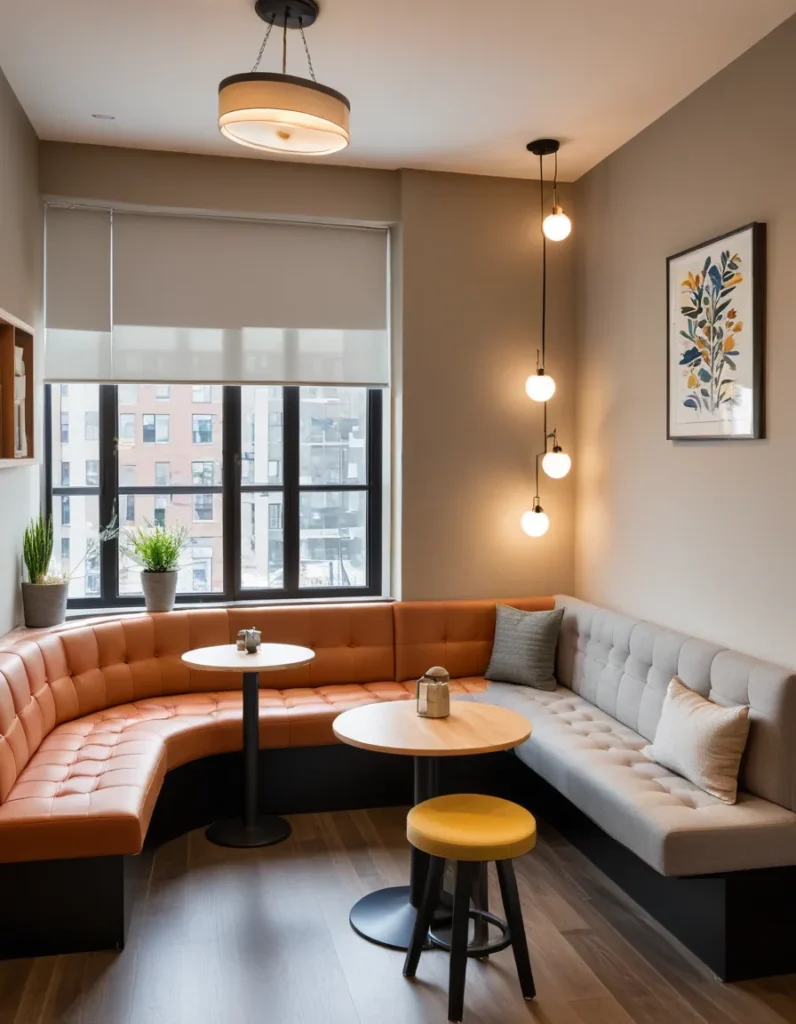
Every productive workshop needs a space for planning, sketching, and taking breaks. A well-designed seating area serves multiple purposes beyond simple rest.
Ergonomic chairs support long planning sessions and detailed drawing work. Position seating areas away from high-noise zones to create natural quiet spaces for concentration and collaboration.
Include a sturdy table suitable for spreading out plans, catalogs, and reference materials. Good lighting in seating areas makes them functional for detailed paperwork and design work.
Comfort elements like cushions or throws make the space more inviting while maintaining the workshop’s practical character. This area often becomes the creative heart where ideas are born and projects are planned.
7. Workshop Ideas for Outdoor Projects

Outdoor workshops offer unique advantages for messy, large-scale, or weather-dependent projects. Design considerations differ significantly from indoor spaces.
Weather protection becomes paramount—retractable awnings or permanent covers provide flexibility while protecting tools and projects from the elements. Consider seasonal storage solutions for equipment that can’t remain outside year-round.
Mobility is key in outdoor setups. Wheeled tool carts and foldable workstations allow quick reconfiguration based on project needs and weather conditions.
Adequate lighting extends working hours and improves safety during dawn and dusk sessions. Solar-powered options can provide independence from electrical infrastructure.
Weather-resistant materials for all permanent fixtures ensure longevity and reduce maintenance requirements. Plan for both summer heat and winter protection in temperate climates.
8. Designing a Workshop with Eco-Friendly Features

Sustainable workshop design benefits both the environment and your operating costs while often creating healthier working conditions.
Reclaimed wood for workbenches and storage adds character while reducing environmental impact. These materials often have superior durability compared to new alternatives.
Energy-efficient LED lighting dramatically reduces power consumption while providing superior illumination. Smart lighting systems can further optimize energy use through automatic scheduling and occupancy detection.
Solar panel systems can power tools and lighting, especially in outdoor or detached workshops. Battery storage systems provide power during outages and peak demand periods.
Rainwater collection systems can supply non-potable water needs like tool cleaning and dust suppression. Green roof systems provide insulation benefits while managing stormwater runoff.
Low-VOC paints and finishes improve indoor air quality while reducing environmental impact. Many eco-friendly options now match or exceed traditional products in durability and appearance.
9. Tips for Soundproofing Your Workshop
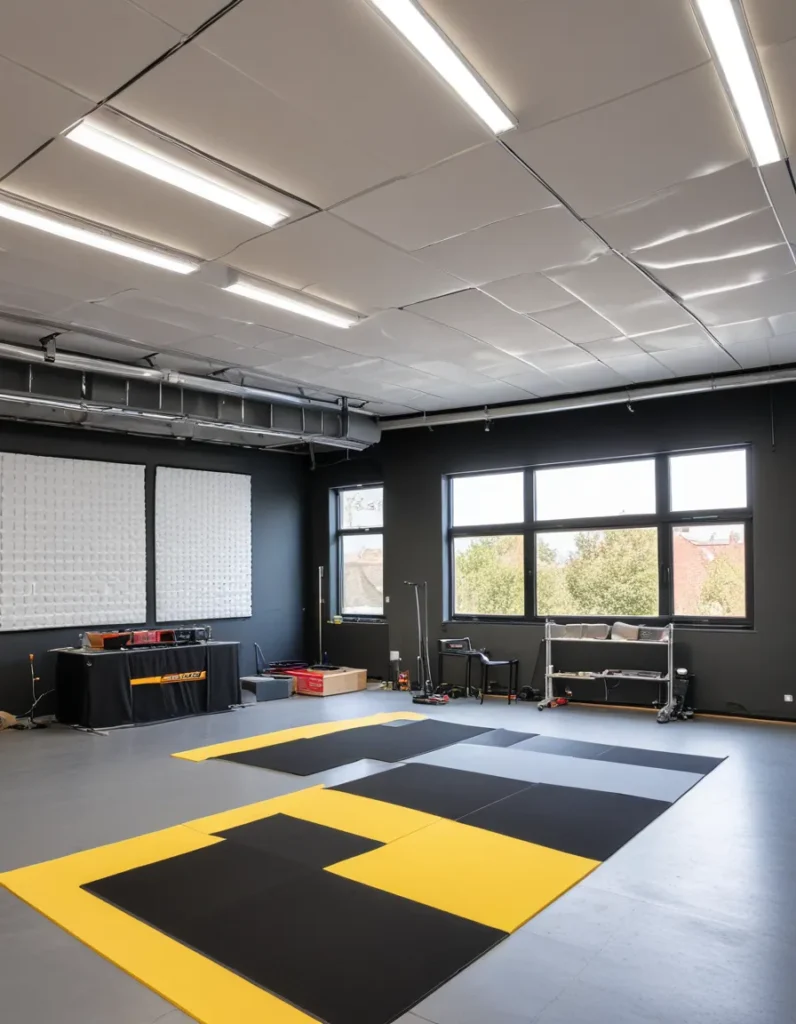
Noise control is essential for maintaining good relationships with neighbors and creating a more pleasant working environment.
Acoustic panels strategically placed on walls and ceilings absorb sound waves and reduce echo. Dense materials like heavy curtains or specialized foam provide additional sound dampening.
Floor treatments like rubber mats or thick carpets absorb vibrations from machinery and footsteps. These materials also provide comfort during long standing sessions.
Seal gaps around doors, windows, and electrical outlets to prevent sound leakage. Weather stripping designed for doors works well for this purpose.
Consider the timing of noisy operations and communicate with neighbors about your schedule. Building goodwill through consideration often prevents conflicts before they start.
10. Workshop Designs for Multi-Purpose Spaces
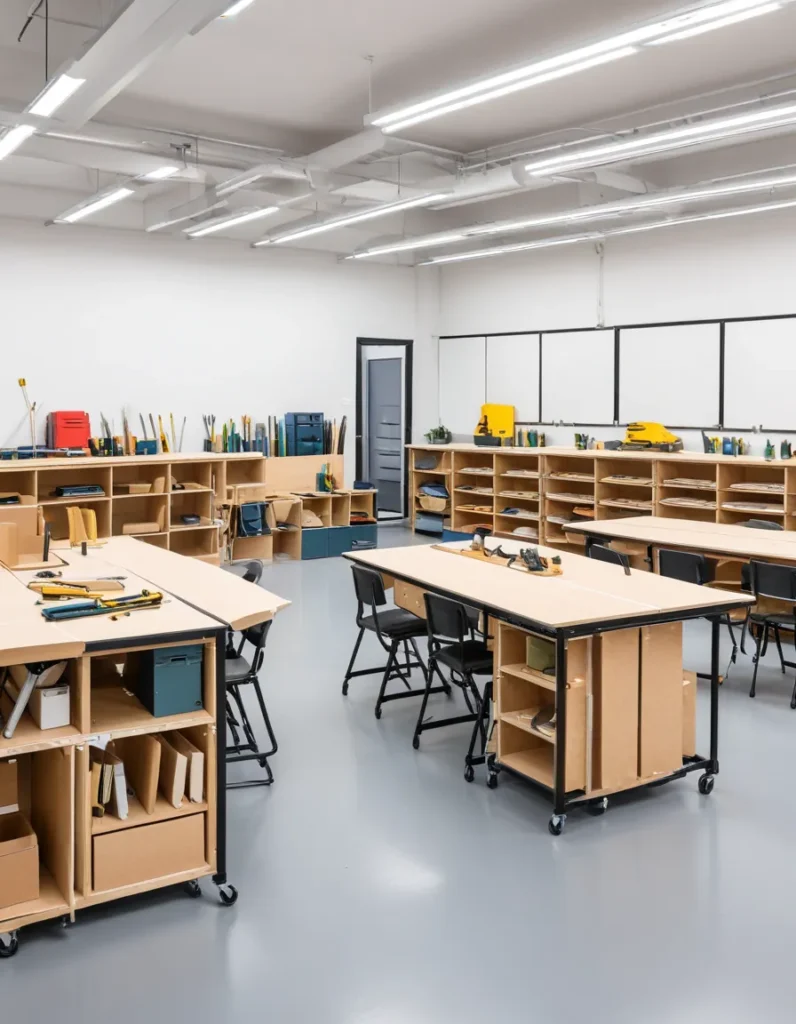
Flexibility is the key to successful multi-purpose workshops. Your design should accommodate various activities without compromising efficiency.
Mobile workbenches and foldable tables allow rapid space reconfiguration. Choose equipment that can serve multiple functions to maximize versatility while minimizing storage requirements.
Versatile storage systems that can accommodate different types of projects prevent the need for complete reorganization when switching between activities.
Modular components like removable partitions allow temporary subdivision of space when needed for different simultaneous activities or to contain dust and noise.
Quick-change setups minimize transition time between different workshop uses. Standardized mounting systems and clearly marked storage make these transitions seamless.
11. Choosing the Right Power Supply Setup for a Workshop

Reliable electrical systems form the backbone of any modern workshop. Proper planning prevents limitations and safety hazards.
Install abundant electrical outlets positioned strategically around workbenches and tool locations. Consider both 120V and 240V requirements for different equipment types.
Backup power systems like generators or battery banks ensure work can continue during outages. Size these systems based on your most critical tools and lighting needs.
Surge protection safeguards expensive tools and equipment from electrical damage. Whole-workshop surge protectors offer better protection than individual outlet units.
Professional electrical installation ensures code compliance and optimal safety. The cost of proper installation is minimal compared to the value of equipment being protected.
12. Installing Durable Shelving in Your Workshop
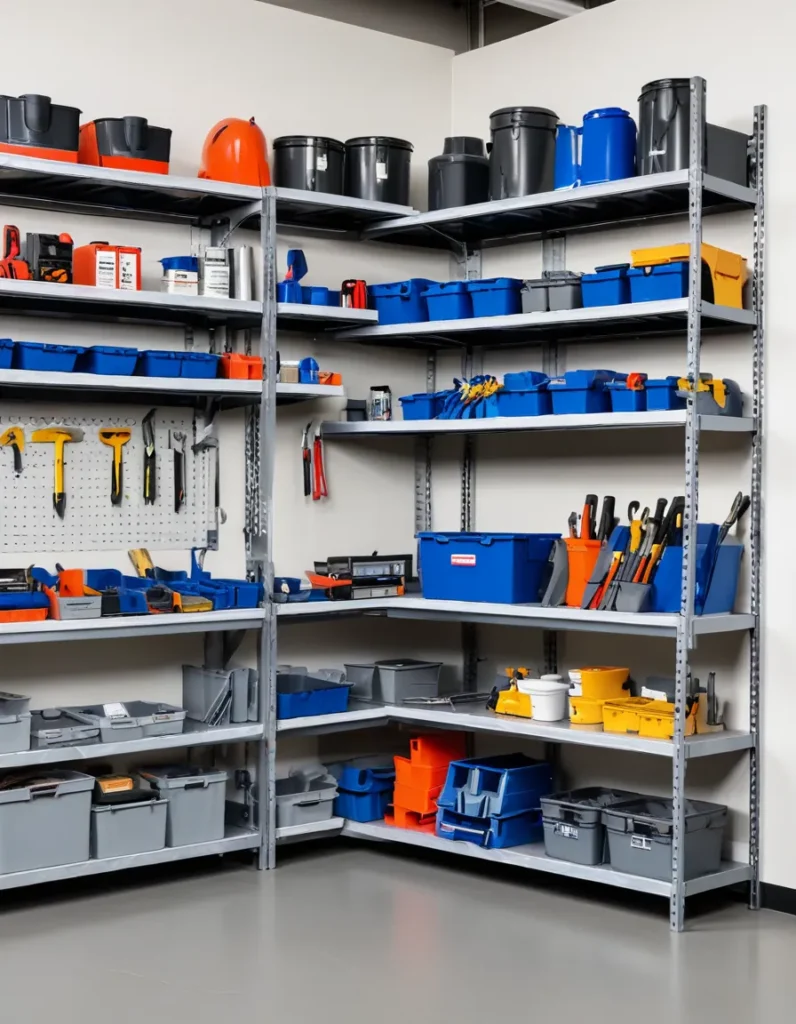
Strategic shelving systems maximize vertical space while keeping materials organized and accessible.
Choose materials appropriate for expected loads—metal shelving for heavy items, reinforced wood for moderate loads. Consider future needs when selecting weight capacities.
Adjustable shelving systems provide flexibility as your storage needs evolve. Look for systems that allow easy reconfiguration without tools.
Position frequently used items at comfortable reaching heights. Reserve high shelves for seasonal or rarely used items to maintain safety and efficiency.
Proper anchoring to wall studs ensures shelf stability under load. Use appropriate fasteners for your wall type and expected shelf loads.
13. Workshop Ideas for Creative Crafts and Hobbies

Creative workshops need different considerations than purely functional spaces. Inspiration and organization must work together harmoniously.
Large work surfaces accommodate spread-out creative projects and allow multiple works-in-progress. Height-adjustable surfaces serve both sitting and standing work preferences.
Colorful, visible storage keeps supplies accessible and can spark creative combinations. Open shelving systems work better than closed cabinets for creative inspiration.
Good lighting becomes even more critical for detailed creative work. Combine general lighting with focused task lighting at each work station.
Personal touches like artwork, inspiration boards, and comfortable seating create an environment that nurtures creativity alongside productivity.
14. Compact Workshop Designs for Garage Spaces

Garage workshops require clever solutions to share space with vehicles and other storage needs.
Foldable and mobile solutions allow the space to serve multiple purposes. Wall-mounted systems keep the floor clear for parking while providing tool access.
Climate control becomes important in garage spaces that experience temperature extremes. Insulation and ventilation improvements create year-round usability.
Dust management protects both workshop projects and stored vehicles. Proper collection systems and sealed storage prevent cross-contamination.
Security considerations differ from dedicated workshop spaces. Ensure valuable tools are properly secured when the garage serves multiple purposes.
15. Adding Natural Light to Your Workshop Design
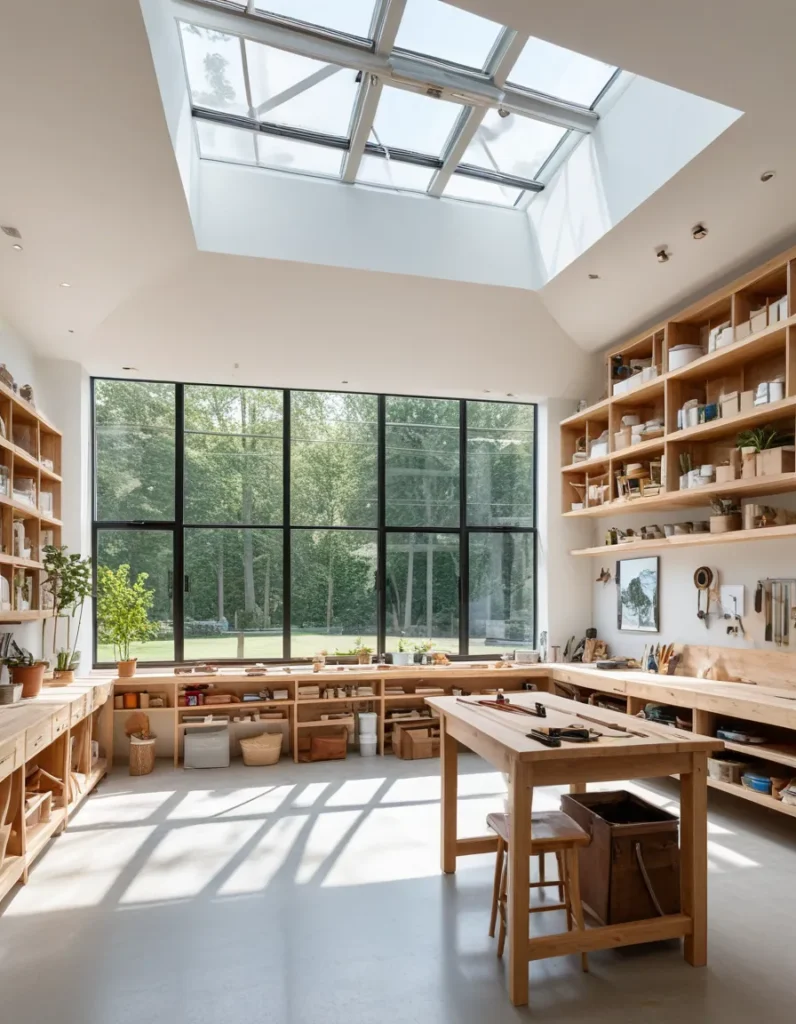
Natural light improves working conditions while reducing energy costs and creating a more pleasant environment.
Large windows, skylights, and glass doors flood the space with daylight while providing visual connections to the outdoors. Position these features to minimize glare on work surfaces.
Privacy solutions like frosted glass or adjustable blinds provide light control without completely blocking natural illumination.
Light shelves and reflective surfaces can redirect natural light deeper into the workspace. Strategic placement of mirrors amplifies available daylight.
Seasonal considerations ensure adequate light year-round. Supplement natural light with artificial sources that match natural color temperatures.
Conclusion: Your Workshop, Your Way
Creating the perfect workshop isn’t about following a rigid formula—it’s about understanding your needs, embracing your creativity, and building a space that evolves with your skills and interests. Each of these 44 ideas offers a building block that you can adapt, combine, and customize to create something uniquely yours.
Remember, the best workshop is the one that gets used. Start with the basics, focus on safety and organization, and gradually add features that enhance your specific interests and projects. Whether you’re building furniture, restoring classics, or crafting tomorrow’s innovations, your workshop should inspire and support your best work.
The journey to your ideal workshop is as rewarding as the projects you’ll complete within it. Take it one improvement at a time, and before you know it, you’ll have created a space that’s not just functional, but truly transformational.
What’s your next workshop upgrade going to be?
